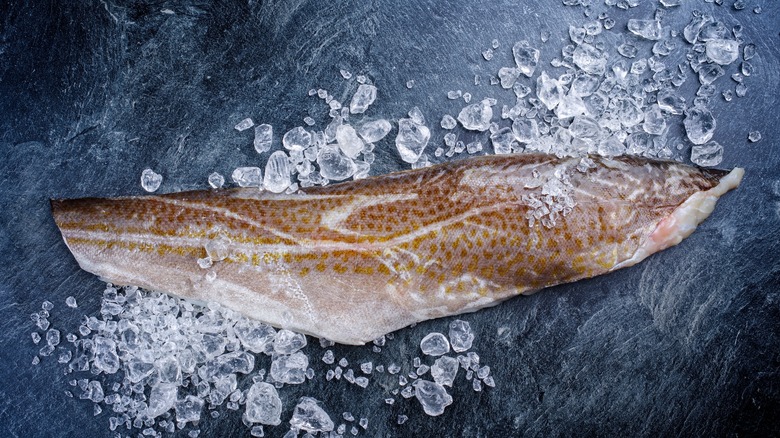No, Your Fish Filet Is Not A Fish Steak. Here's The Difference
Just glance at a butcher stand, and the extensive terminology used for meat is immediate. The world of fish mongering looks a bit different — the type of species is highlighted more prominently. When it comes to cuts, it may seem confined to whether the fish is whole, or in filet form. Yet look into the specifics, and there are many variations to uncover.
From loin cuts, to a butterfly filet, and the underrated fish collar, how you slice the animal makes a difference, too. And one of the most often-confused distinctions is the fish filet and steak. Seeing as they're both larger fish cuts, shoppers might mistakenly think they're the same. However, steaks are thick cuts perpendicular to the bone, resulting in large crosswise sections. Meanwhile, the popular filet cut is sliced lengthwise along the spine, resulting in a thinner, longer piece of fish.
Steaks are typically kept both bone-in and skin-on, and hail from larger, more meaty fish. Filets get rid of all the bones from the spine, although there might still be some pin-bones left to remove. This cut is available both skinless and skin-on, and is available for a larger array of fish. As a result, their accompanying culinary uses between the two cuts vary, so knowing the nuances is hugely helpful.
Versatile fish filets come in many forms
Filets are the most common type of fish butchery, so they understandably come with lots of nuance. In fact, you'll find them for just about any fish variety that's at least medium size. Filleting is widespread, so it can simply mean requesting some careful cuts from a fishmonger. However, since the thin, mostly boneless nature of filets makes them super easy to cook, fish-packing plants often take care of the task soon after a fresh catch.
To accommodate varying species and designated uses, fish filets are further subdivided into three main types. First, there are whole fish filets, which are actually rare in the U.S., since they include skin, some bones, and the tail. More widespread is the V-cut, which serves to slice away the pin bones, and several fish flaps. And for the leanest — yet most expensive option — there's the J cut, which takes off an additional fatty piece of fish belly.
Throw in the fact that fish have varying bone compositions, which also affects the filetting, and filets can result in many forms. So whether you're searing, baking or poaching, test filets are the secret to cooking fish stress-free. This cut often turns out tasty, but there are many details to keep track of.
Fish steaks are meatier cuts primed for higher heat cooking
The fish steak is a heftier cut, so it accordingly stems from larger fish, with ten pounds being the minimum weight. Meatier species like halibut, salmon, mahi mahi, swordfish and tuna are the most popular candidates. Since the cut is crosswise, there'll be a large vertebrae bone in the fish. Although, with larger animals like tuna, it's typically removed prior to sale. And even though there's often skin, the steaks are descaled, so it's an edible component. Preferably, you should leave it adhered during preparation, to avoid one of the big mistakes when cooking fish.
Fish steaks can be used in cooking applications like frying, show up in canned food, and be baked, although they're often best with high heat. The flesh is tender and juicy, but will cook quickly, so a nice sear really benefits the cut. And with their thickness, many fish steaks can be thrown directly on the grates to amplify smokey notes — a move not possible with filets. With tuna, you can even mimic the medium-rare nature of beef, leaving the interior a nice pink.
With smaller animals, it's possible to craft fish steak medallions yourself, or to ask a friendly fishmonger for help. However, larger animals require an industrial cut to slice through the vertebrae, so your selection will be confined to what's for sale.


